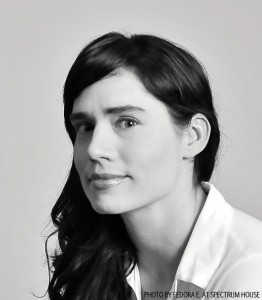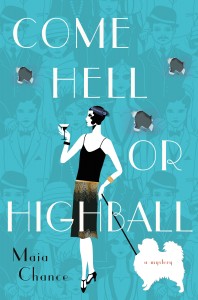I am delighted to welcome fellow mystery writer Maia Chance to Not Even Joking today! I asked Maia to discuss motherhood and writing and inspiration… subjects that are very close to my heart. And be sure to check out the info below on Maia’s latest novel, Come Hell or Highball. I’ve already added it to my Goodreads “To Read” list.
Thank you for having me as a guest on your wonderful blog, Nina!
I was enchanted by the fact that Nina takes the time to discuss motherhood here on her blog. Lots of writers are moms but we don’t talk about it much, except to commiserate about how strapped for bandwidth we are. Or sometimes, how weird it is to look your kid’s kindergarten teacher in the eye when you’re daydreaming about how to murder someone. However, I’m going to admit something a little—perhaps—peculiar. I get inspired as a writer by my kids’ toys and picture books.
As a cozy mystery writer, my daily work involves manipulating characters within microcosmic communities. I often reflect, as my eyes drift around the child-colonized rooms I work in, that playing with a Playmobil or Brio train set also amounts to manipulating characters within microcosmic communities. My kids stage dramas in the dollhouse with Calico Critters chipmunks, Lightning McQueen, and a plastic Tyrannosaurus Rex. . .and this is the cozy mystery genre. I mean, what is the English country house setting of classic whodunits but a dollhouse? (And I didn’t want to mention it, but doesn’t Hercule Poirot look like one of those bald Little People guys?) Those brightly-painted toy play sets, and the way my kids go at them, remind me that writing, too, should have that same spontaneous and even wacky flow.
One of the writers I’ve worked with a great deal in my academic work, Nathaniel Hawthorne, was fascinated with the connection between toys and the imagination (he was devoted to his kids). In “The Custom-House,” a preface to The Scarlet Letter, the narrator describes a boundary-space of inspiration:
“A child’s show; the doll, seated in her little wicker carriage; the hobby-horse; —whatever, in a word, has been used or played with during the day, is now invested with a quality of strangeness and remoteness . . . the floor of our familiar room has become a neutral territory, somewhere between the real world and fairy-land, where the Actual and the Imaginary may meet.”
Interesting that this imaginative boundary-space is occupied by toys, isn’t it? I think Hawthorne is getting at how toys take us to an Other space that is alive with possibility, ripe for manipulation and imaginative investment, but never totally ownable. Words are also like this. Words are, in a way, toys.
And the kid’s books. Oh, the kid’s books. I often think these are THE perfect art form. I adore everything Maurice Sendak ever breathed life into, and I also never tire of Richard Scarry and William Steig. Novelists can only envy the magic of a picture book: that synergy that arises in the space between the words and the illustrations. I wonder if there is something to be learned there, something about not overwriting the story, about allowing unnarrated images to speak for themselves.
I notice that the picture books I enjoy the most are those with inky black outlined images filled in with vibrant color. (Those blurry Madeline books never really did it for me.) Something about crisp cartoony images resonates with my private vision of storytelling. Critical theorists write about how naming things with words pulls them forth from the undifferentiated mass of the universe; naming things with words makes the world. I wonder if a black-outlined cartoon image works in a similar fashion, clarifying, differentiating, making. Richard Scarry’s cartoon pigs in trousers, his watermelon trucks and rabbit dentists all in stark outline, they don’t apologize for their own vivid absurdity. Scarry made a world.
It’s no mystery why children’s picture books and toys inspire and refresh me so much as a writer. They provided my first experiences with narrative, drama, mystery, and adventure. And even now I love them dearly—except for those tiny Lego pieces I always seem to step on when I’m barefoot, of course.
 Maia Chance writes historical mystery novels that are rife with absurd predicaments and romantic adventure. She is the author of the Fairy Tale Fatal and The Discreet Retrieval Agency series. Her first mystery, Snow White Red-Handed, was a national bestseller. Her latest releases are Cinderella Six Feet Under and Come Hell or Highball.
Maia Chance writes historical mystery novels that are rife with absurd predicaments and romantic adventure. She is the author of the Fairy Tale Fatal and The Discreet Retrieval Agency series. Her first mystery, Snow White Red-Handed, was a national bestseller. Her latest releases are Cinderella Six Feet Under and Come Hell or Highball.
Visit Maia on the web on her website maiachance.com, or her Facebook Page, on Goodreads or on Twitter.
 31-year-old society matron Lola Woodby has survived her loveless marriage with an unholy mixture of highballs, detective novels, and chocolate layer cake, until, her husband dies suddenly, leaving her his fortune…or so Lola thought. As it turns out, all she inherits from Alfie is a big pile of debt. Pretty soon, Lola and her stalwart Swedish cook, Berta, are reduced to hiding out in the secret love nest Alfie kept in New York City. But when rent comes due, Lola and Berta have no choice but to accept an offer made by one of Alfie’s girls-on-the-side: in exchange for a handsome sum of money, the girl wants Lola to retrieve a mysterious reel of film for her. It sounds like an easy enough way to earn the rent money. But Lola and Berta realize they’re in way over their heads when, before they can retrieve it, the man currently in possession of the film reel is murdered, and the reel disappears. On a quest to retrieve the reel and solve the murder before the killer comes after them next, Lola and Berta find themselves navigating one wacky situation after another in high style and low company.
31-year-old society matron Lola Woodby has survived her loveless marriage with an unholy mixture of highballs, detective novels, and chocolate layer cake, until, her husband dies suddenly, leaving her his fortune…or so Lola thought. As it turns out, all she inherits from Alfie is a big pile of debt. Pretty soon, Lola and her stalwart Swedish cook, Berta, are reduced to hiding out in the secret love nest Alfie kept in New York City. But when rent comes due, Lola and Berta have no choice but to accept an offer made by one of Alfie’s girls-on-the-side: in exchange for a handsome sum of money, the girl wants Lola to retrieve a mysterious reel of film for her. It sounds like an easy enough way to earn the rent money. But Lola and Berta realize they’re in way over their heads when, before they can retrieve it, the man currently in possession of the film reel is murdered, and the reel disappears. On a quest to retrieve the reel and solve the murder before the killer comes after them next, Lola and Berta find themselves navigating one wacky situation after another in high style and low company.





